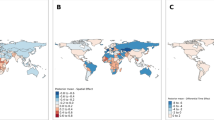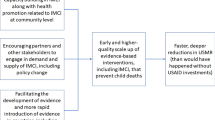Abstract
Objectives
To analyze the effect of Official Development Aid (ODA) dollars on child mortality over the course of the United Nation’s Millennium Development Goals initiative.
Methods
The relationship between child mortality and Official Development Aid over the duration of the Millennium Development Goals (2000–2015) is examined here using a longitudinal panel of country-level data from the World Bank and the United Nations. An Ordinary Least Squares regression approach was used with country-level fixed effects. Models were estimated for the full sample and by Human Development Index development strata (high, medium, and low developed countries) with clustered standard errors.
Results
ODA appears to be most strongly associated with decreases in child mortality in Medium Developed Countries. Every one dollar per capita increase in ODA is associated with a 0.035 decrease in child deaths per 1000 births.
Conclusions
Significant gains were made in decreasing child mortality over the last 15 years. The need for more progress remains. Allocation of ODA to developing countries can be an effective policy tool in achieving public health goals.
Similar content being viewed by others
References
Aidoo, Michael, Terlouw, Dianne J, Kolczak, Margarette S, McElroy, Peter D, Kuile, Feiko O ter, Kariuki, Simon, Nahlen, Bernard, Lal, Altaf A, Udhayakuma, Venkatachalam (2002) Protective effects of the sickle cell gene against malaria morbidity and mortality. Lancet 359(9314):1311–1312
Allen, Linday H. (2000) Anemia and iron Deficiency: effects on pregnancy and outcome. Am J Clin Nut 71(5):1280–1284
Ballweg JA, Pagtolun-An Imelda G (1992) Parental underinvestment: a link in the fertility-mortality continuum. Pop Res Pol Rev 11.1: 73–89.
Boone P (1996) Politics and the effectiveness of foreign aid. Eur Econ Rev 40:289–329
Dietrich S (2011) The politics of public health aid: why corrupt governments have incentives to implement aid effectively. World Dev 39(1):55–63
Dunning T (2004) Conditioning the effects of aid: cold war politics, donor credibility, and democracy in Africa. Int Org (No. 02) 58: 409–423.
Easterly W (2001) The Elusive quest for growth. MIT Press, Cambridge
Easterly W (2009) How the millennium development goals are unfair to Africa. World Devel 37(1):26–35
Filmer, Deon, Leon H. Pritchett (1999) The impact of public spending on health: does money matter? Soc Sci Med 49: 1309–1323.
Fleck, Robert K., Kilby, Christopher (2010) Changing aid regimes? U.S. foreign aid from the cold war to the war on terror. J Dev Econ 91(2):185–197
Fretts, Ruth C, Schmittdiel, Julie, McLean, Frances H, Usher, Robert H, Goldman, Marlene B (1995) Increased maternal age and the risk of fetal death. New Eng J Med 333:953–957
Goli S, Arokiasamy P (2014) Maternal and child mortality indicators across 187 countries of the world: converging and diverging. Glob Pub Health (No. 03) 9: 342–360.
Griffin K.(1991) Foreign aid after the cold war. Dev Change 22: 645–685.
Hansen H, Tarp F (2001) Aid and growth regressions. J Dev Econ 64:547–570
Knack S (2000) Aid dependence and the quality of governance: a cross-country empirical analysis. The World Bank, Washington, D.C
Knack S, Keefer P (1997) Does social capital have an economic payoff? a cross-country investigation. Quart J Econ 112(1997):1252–1288
Mahy M (2003) Childhood mortality in the developing world: a review of evidence from the demographic and health surveys. DHS Comparative Reports No. 4. ORC Macro, Calverton, Maryland
Maizels A, Nissanke MK (1984) Motivations for aid to developing countries. World Dev 12(9):879–900
Martin SP (2000) Diverging fertility among U.S. women who delay childbearing past age 30. Demography 37(4):523–533
Moalem S, Prince J (2007) Survival of the sickest: the surprising connections between disease and longevity. Harper Perennial, New York
Moyo D (2009) Dead aid: why aid is not working and how there is a better way for Africa. Farrar, Strauss and Giroux, New York.
Mujica O, Vasquez E, Duarte EC, Cortez-Escalante JJ, Molina J, Silva JB Jr (2014) Socioeconomic inequalities and mortality trends in BRICS, 1990–2010. Bull World Health Organ 92(405):405–412
OECD (2008) The Paris declaration on aid effectiveness and the accra agenda for action. http://www.oecd.org. http://www.oecd.org/dac/effectiveness/34428351.pdf. Accessed 16 Nov 2015.
OECD (2015) Official development assistance: definition and coverage. http://www.oecd.org/dac/stats/officialdevelopmentassistancedefinitionandcoverage.htm. Accessed 20 Nov 2015.
Ovaska T (2003) The failure of development aid. Cato J 23(2):175–188
Millennium Promise (2009) Millennium development timeline. http://mp.convio.net/site/DocServer/MP_Timeline.pdf?docID=1502. Accessed 15 Nov 2015.
Rindfuss RR, Morgan SP, Offutt K (1996) Educating and the changing age pattern of american fertility: 1963–1989. Demography 33(3):277–290
Sartorius BK (2014) Global infant mortality trends and attributable determinants: an ecological study using data from 192 countries for the period 1990–2011. Pop Health Metrics 12:29
Sen A (1999) Development as freedom. Anchor Books, New York
Smith GCS, Pell JP (2001) Teenage pregnancy and risk of adverse perinatal outcomes associated with first and second births: population based retrospective cohort study. Brit Med J 323:476
Stephansson O, Dickman PW, Johansson A, Cnattingius S (2000) Maternal hemoglobin concentration during pregnancy and risk of stillbirth. J Am Med Assoc 284(20):2611–2617
Tacke T, Waldmann RJ (2013) Infant mortality, relative income and public policy. Appl Econ 45:3240–3254.
The World Bank (2015) World development indicators. http://data.worldbank.org/data-catalog/world-development-indicators. Accessed 15 Sep 2015.
Trumbull WN, Wall HJ (1994) Estimating aid-allocation criteria with panel data. Econ J 104(425):876–882
UNDP (2011) Towards human resilience: sustaining MDG progress in and age of economic uncertainty. Bureau for development policy, United Nations development programme. UNDP, New York.
United Nations (2014) Human development report. http://hdr.undp.org/en/content/human-development-index-hdi. Accessed 15 Sep 2015
United Nations (2015a) Goal 3: ensure healthy lives and promote well-being for all at all ages. http://www.un.org/sustainabledevelopment/sustainable-development-goals. Accessed 16 Nov 2015
United Nations (2015b) News on millennium development goals 2015. http://www.un.org/millenniumgoals. Accessed 17 Nov 2015
United Nations (2015c) Sustainable development goals 2015. https://sustainabledevelopment.un.org. Accessed 17 Nov 2015
United Nations (2015d) The millennium development goals report. United Nations. July 2015. http://www.un.org/millenniumgoals/news.shtml. Accessed 10 Nov 2015
WHO (2002) Report of the commission on macroeconomics and health. Regional office for South-East Asia, World Health Organization, Jakarta
Williamson CR (2008) Foreign aid and human development: the impact of foreign aid to the health sector. South Econ J 75(1):188–207
Zanger SC (2000) Good governance and European Aid: the impact of political conditionality. Eur Un Pol 1(3):293–317
Author information
Authors and Affiliations
Corresponding author
Ethics declarations
This study was not funded by any grant.
Ethical approval
This article does not contain any studies with human participants or animals performed by any of the authors.
Additional information
This article is part of the special issue “Development and Public Health”.
Rights and permissions
About this article
Cite this article
Winkleman, T.F., Adams, G.B. An empirical assessment of the relationship between Official Development Aid and child mortality, 2000–2015. Int J Public Health 62, 231–240 (2017). https://doi.org/10.1007/s00038-017-0940-2
Received:
Revised:
Accepted:
Published:
Issue Date:
DOI: https://doi.org/10.1007/s00038-017-0940-2




